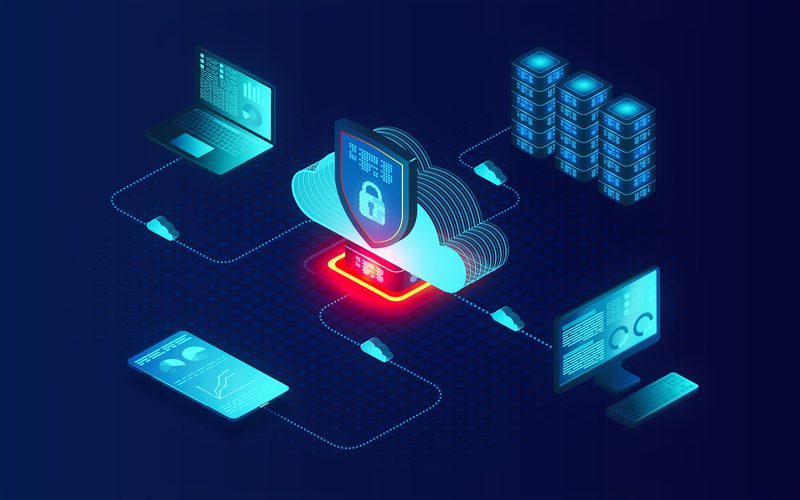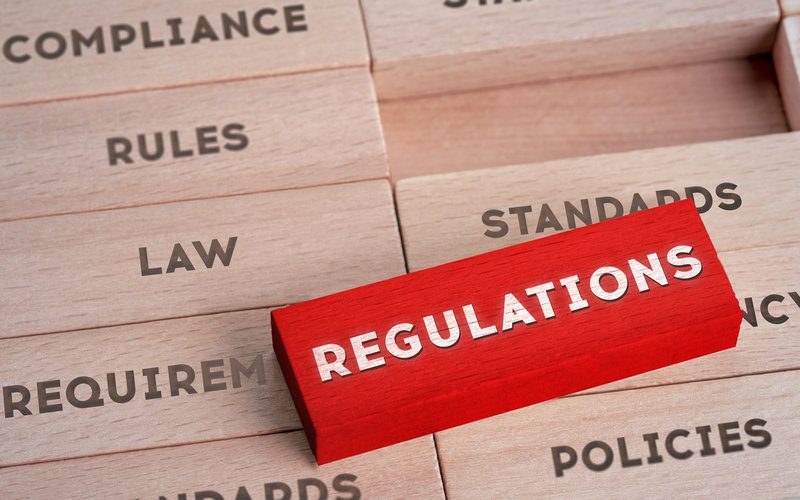IT compliance refers to a set of statutory rules and regulations that businesses must follow to minimize the threat of a cyberattack and keep their systems and processes secure. Every organization must adhere to industry standards and regulations relevant to their business.
What is IT compliance?
Compliance guidelines outline the standards for IT infrastructure design, data sharing and storage, and digital communication to prevent unauthorized entities from accessing or manipulating confidential information. Regulatory authorities thoroughly explain each rule so that companies clearly know what they have to do to stay compliant.
The state, federal and international regulatory bodies develop these guidelines to ensure businesses follow the necessary IT best practices to maintain data integrity and the security of their IT infrastructure. Following these rules is mandatory and not complying is considered a violation of the guidelines, which attracts heavy fines and penalties.
In this blog, we’ll explore the purpose of IT compliance, discuss various compliance regulations and standards, and understand the role and responsibilities of an IT compliance manager.
What is the purpose of IT compliance?
The goal of IT compliance is to maintain the safety and security of an organization’s digital assets. In recent years, governments have taken a hard stance on IT compliance in response to rising cybercrime and concerns about data security and privacy. As a result, companies are being asked to adhere to more and more compliance regulations every day to keep threats at bay. According to Refinitiv’s global risk and compliance report 2021, 64% of respondents said that they’ll focus more on being regulatory compliant rather than proactively trying to prevent issues.
Note: The increasing demand for compliance services has presented a new business opportunity for MSPs. According to Kaseya’s 2022 MSP Benchmark Survey, nearly 75% of respondents currently offer or are planning to provide compliance services to clients.
Following these regulations does much more for a business than just protect them from heavy fines and violations. Companies are obligated to invest in a solid IT security infrastructure, which automatically minimizes the risk of cyberattacks and breaches. Today, many clients and customers will only do business with companies that adhere strictly to the compliance requirements for their industry. By staying compliant with regulations, you can earn the trust of your customers and win more business.
What is a compliance standard?
Keeping up with compliance regulations isn’t as simple as it seems. To stay within the guidelines, you must test your systems and processes on a regular basis. Compliance standards are a set of best practices against which companies can test whether their IT framework meets compliance requirements or not. Compliance standards outline best practices as well as suggestions to address common problems to make your business more compliant.
Compliance is an ongoing process, i.e., you must run a compliance check every time you upgrade your IT infrastructure. This will keep you on the good side of both the law and your customers, and safe from potentially devastating cyberattacks.
IT compliance standards and regulations
The compliance guidelines do not apply to your business as a whole. Instead, they apply to specific aspects of your business. Also, you won’t be subject to all the compliance regulations of a country or region.
There are a variety of compliance requirements, each geared towards different objectives. HIPAA and PCI-DSS compliance regulations are specific to companies in the healthcare and financial sector, and are intended to protect their customers’ personal information. Others, such as SOC2, are applicable to cloud providers who host critical data of other organizations. Then there’s a region-specific regulation like GDPR applicable to all companies doing business in or handling the data of European Union (EU) customers.
Let’s examine some of the common IT compliance standards and regulations.
GDPR (General Data Protection Regulation)
General Data Protection Regulation (GDPR) is a European Union (EU) compliance standard under which businesses are required to protect the personal data and privacy of EU citizens for all transactions that are performed within the EU member states. It is intended to reinforce and unify data protection for all individuals that reside within the EU and control the export of personal data outside the EU. There are two levels of penalties for GDPR noncompliance, with the upper level having fines of up to 20 million euros or 4% of the prior year’s annual revenue, whichever is higher.
HIPAA (Health Insurance Portability and Accountability Act)
Health Insurance Portability and Accountability Act (HIPAA) is a U.S. compliance standard designed to protect sensitive patient data. All organizations dealing with protected health information (PHI) are required to maintain and follow process, network and physical security measures in order to be HIPAA compliant. HIPAA penalties can be significant. The civil penalties for HIPAA violations start at $100 and go up to $25,000 for multiple violations. The minimum penalty for willful violations is $50,000 and the maximum criminal penalty for a HIPAA violation by an individual is $250,000. That’s not all. A violation of HIPAA can also result in jail terms of up to 1, 5 or 10 years. The maximum penalty is $1.5 million.
PCI DSS (Payment Card Industry Data Security Standard)
Payment Card Industry Data Security Standard, commonly referred to as PCI DSS, is a regulatory framework designed to protect the personal payment data of customers whenever it is processed, transmitted or stored by companies they transact with. All merchants who accept payment cards are required to comply with PCI DSS. Fines for violating this regulation can go up to $500,000 per incident for security breaches.
SOX (Sarbanes-Oxley Act)
The Sarbanes-Oxley Act of 2002 was developed in order to protect investors from fraudulent financial reporting by publicly traded corporations. The early 2000s were filled with scandals relating to such matters. Under the Act, U.S. public companies and public accounting firms are required to keep financial records in an ethical and correct manner. Several provisions of the Act also apply to privately owned companies.
FISMA (Federal Information Security Management Act)
FISMA is a United States federal law passed in 2002. It requires government agencies, including their contractors, to implement a security framework to safeguard sensitive government information. This regulation requires that all federal agencies and their affiliates comply with information security standards and guidelines as well as mandatory NIST standards.
CMMC (Cybersecurity Maturity Model Certification)
The CMMC 2.0 is a comprehensive framework under development by The Department of Defense (DoD) to protect the defense industrial base from increasingly frequent and complex cyberattacks. As of November 2021, the CMMC 2.0 replaced the CMMC 1.0, keeping the goal of safeguarding national security information at its core. The framework involves a lot of moving parts which have not been finalized yet.
NIST CSF (National Institute of Standards and Technology Cybersecurity Framework)
The NIST Cybersecurity Framework is a voluntary framework that consists of standards, guidelines and best practices issued by the U.S. Department of Commerce. It is a collaborative effort between the public and private sectors and academia. It was originally targeted at improving cybersecurity for critical infrastructure sectors in the United States. Those key sectors included finance, energy, healthcare and defense. It was also intended to be used by federal agencies as well as state and local governments.
SOC (System and Organization Controls) reports
Despite taking necessary precautions, many companies have fallen victim to cyberattacks due to poor cybersecurity at their vendor firms or any other company in the supply chain. To avoid being hacked or breached, clients prefer working with companies that comply with all the necessary security regulations and can provide proof of the same. A SOC report serves as proof of a company’s reliability. SOC examinations and reports are created by Independent Certified Public Accountants (service auditors) under the American Institute of Certified Public Accountants’ (AICPA) attestation standards. Because SOC reports are created by third-party auditors, they build credibility and trustworthiness in the organization. There are four types of SOC reports – SOC 1, SOC 2, SOC 3 and SOC for cybersecurity.
What is an IT compliance audit?
IT compliance rules are enforced to ensure that companies follow fair and ethical business practices that do not compromise the rights of employees, clients, customers and the continued existence of the company overall. However, just enforcing compliance is not sufficient. The regulatory authorities must periodically check whether the companies are complying with the rules and regulations. Without checks, companies could disregard the guidelines in order to maximize profits.
Let’s take the credit card industry as an example. Customers are at risk of losing their financial and personal information if credit card merchants do not follow mandatory cybersecurity regulations.
Compliance audits are used as a measure to determine whether compliance codes, guidelines and controls are being followed. Regulatory agencies require companies to conduct compliance audits regularly and report the findings. It is also necessary for companies to perform compliance audits when they make major changes to their IT infrastructure or policies. Regulatory agencies may also commission an audit to determine whether a company is compliant.
A regulatory authority may send compliance auditors to the company or request that the company hire third-party compliance auditors to conduct a compliance audit.
Note: Unlike internal audits, which a company conducts to ensure compliance with its internal rules and policies, IT compliance audits are conducted by external parties to determine their accuracy. Companies should conduct an internal IT compliance audit before the final audit to ensure all is in place.
Auditors begin by defining the scope of the audit. The audits can be completed telephonically by asking the people concerned a series of questions. More often than not, auditors work from the office premises of the business being audited, inspecting infrastructure and the work environment as part of the process.
Following the audit, the auditor prepares a report and submits it to the management and the regulatory body. The report indicates which checks passed, which failed and where the company needs to improve. The appropriate measures for becoming compliant are also outlined as part of the report. Following an audit, companies are generally given 120 days to implement corrective measures. A fine may be imposed if there are grave and intentional lapses in compliance, or if corrective measures aren’t implemented within the 120 days timeframe.
Who is responsible for IT compliance?
Most companies have a compliance manager who oversees compliance activities. Smaller businesses can function well with just one compliance manager while larger organizations can have one for each department with a number of compliance officers reporting to them. With the government cracking down even more on compliance implementation, many companies have also created the post of chief compliance officer to ensure watertight enforcement. According to the Thomson Reuters Fintech, Regtech and the Role of Compliance Report 2021, 15% of respondent firms have invested in specialist skills for the risk and compliance function while 24% have not yet done so but know it is needed.
The regulatory bodies are also pushing boards to take an active role in compliance and holding them accountable when mishaps occur. The purpose is to encourage leadership participation in compliance activities.
A compliance manager is not the only person responsible for overseeing conformity to compliance rules. With regards to IT compliance, it is also the responsibility of the entire IT team to make sure all policies and rules are followed in full. Any company employee who notices non-compliance, whether intentional or unintentional, should notify the correct committee or bring it to the attention of the people concerned.
What does an IT compliance manager do?
A compliance manager’s role is similar to that of a third-party compliance auditor. Their primary role is to carry out regular internal audits to ensure the business and the departments concerned are in compliance with the stipulated rules and regulations. Additionally, they maintain reports related to compliance so that they are available when needed.
Compliance managers also work with third-party compliance auditors and provide them with the documents and information they need to complete their work. Along with these operational tasks, IT compliance managers are also responsible for developing strategies that ensure IT compliance. In a nutshell, an IT compliance manager’s role is to identify and minimize the challenges that lead to non-compliance.
The following are the roles and responsibilities of a compliance manager:
- Ensuring conformity to compliance guidelines
- Compiling compliance documentation
- Setting up a self-audit and reporting schedule
- Managing audit and compliance requirements for various departments
- Developing strategies to prevent non-compliance with the guidelines
- Coordinating and strategizing with all employees that influence compliance rules directly
- Resolve issues related to compliance
- Provide leadership, management, and the board of directors with timely and comprehensive reports
- Filling out regulatory reports and other paperwork
- Implementing new or updated policies and directives, as necessary and providing training
What is IT compliance software?
Compliance is not an easy process for businesses to manage. The ever-changing rules and the fear of penalties make it more difficult to manage than it seems. It’s a long-term project that requires coordination between multiple teams and employees. There will be failures and confusion if a streamlined process is not in place.
An IT compliance software simplifies the process and ensures that all stakeholders have access to all the relevant data and information whenever they need it. Many tools provide users with features and templates to create reports and capabilities to share them with the authorities concerned. Furthermore, the tool helps to identify challenging areas early on, so that stakeholders can make informed decisions and take remedial actions.
These are some of the benefits of investing in an IT compliance software:
Efficient compliance management: Documentation is an integral part of compliance work. IT Compliance solutions prevent creation of duplicate documents that can clog up workflow, thus enabling operational efficiency and streamlining compliance processes.
Cost management: Managing compliance without a compliance management tool in your tech stack can be time consuming and inefficient. You’ll need more hands to manage the task, and it isn’t the most efficient method. With a compliance manager solution in your tech stack, you can manage everything more efficiently and without hiring additional staff.
Streamline the process: With IT compliance tools, you can automate a number of smaller day-to-day tasks that take a lot of time. Additionally, the tool acts as a central hub for organizing work and storing documents, which helps eliminate information silos that prevent compliance.
Ensure compliance: The biggest step you can take to ensure full compliance with all regulations is to invest in an IT compliance tool. Based on the policies and rules applicable to you, you can develop a compliance management roadmap. Additionally, the tool will send you notifications and alerts when a certain area needs to be corrected or improved.
IT compliance and Compliance-as-a-Service with Kaseya
The Compliance Manager solution by Kaseya offers a host of useful features and capabilities, such as automated assessments, risk-based mediation and detailed reports of compliance-based activities.
It combines a wizard-driven workflow engine, automatic detection of network and computer data, a web-based management portal, and built-in compliance document generation to help you maintain and prove compliance. If you are an MSP, you can leverage the tool to offer Compliance-as-a-Service to your clients and unlock a new revenue stream.
Designed to meet your growing compliance needs, Compliance Manager will help you stay compliant with even the most complex guidelines and regulations. To find out more, click here for a free Compliance Manager demo.





